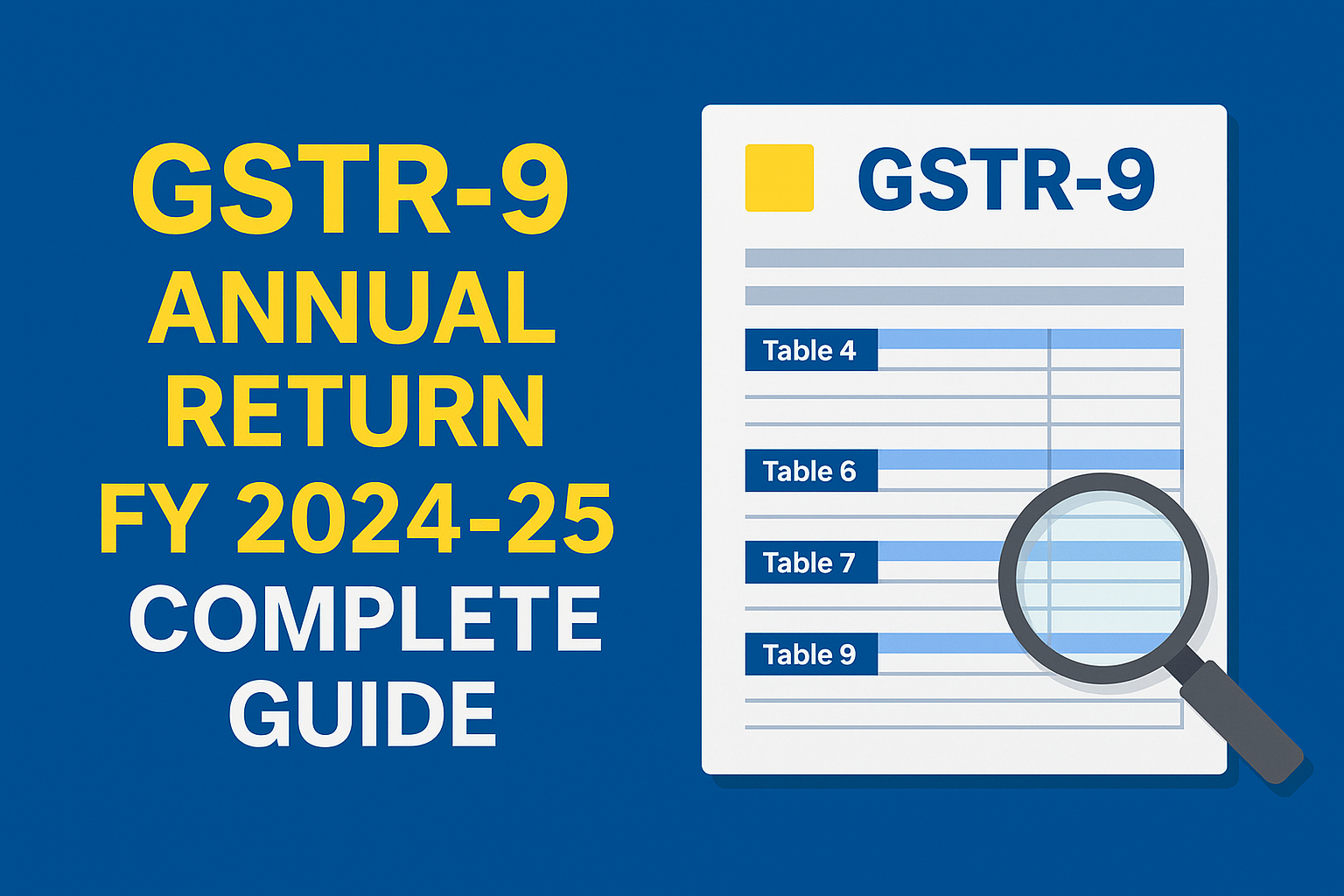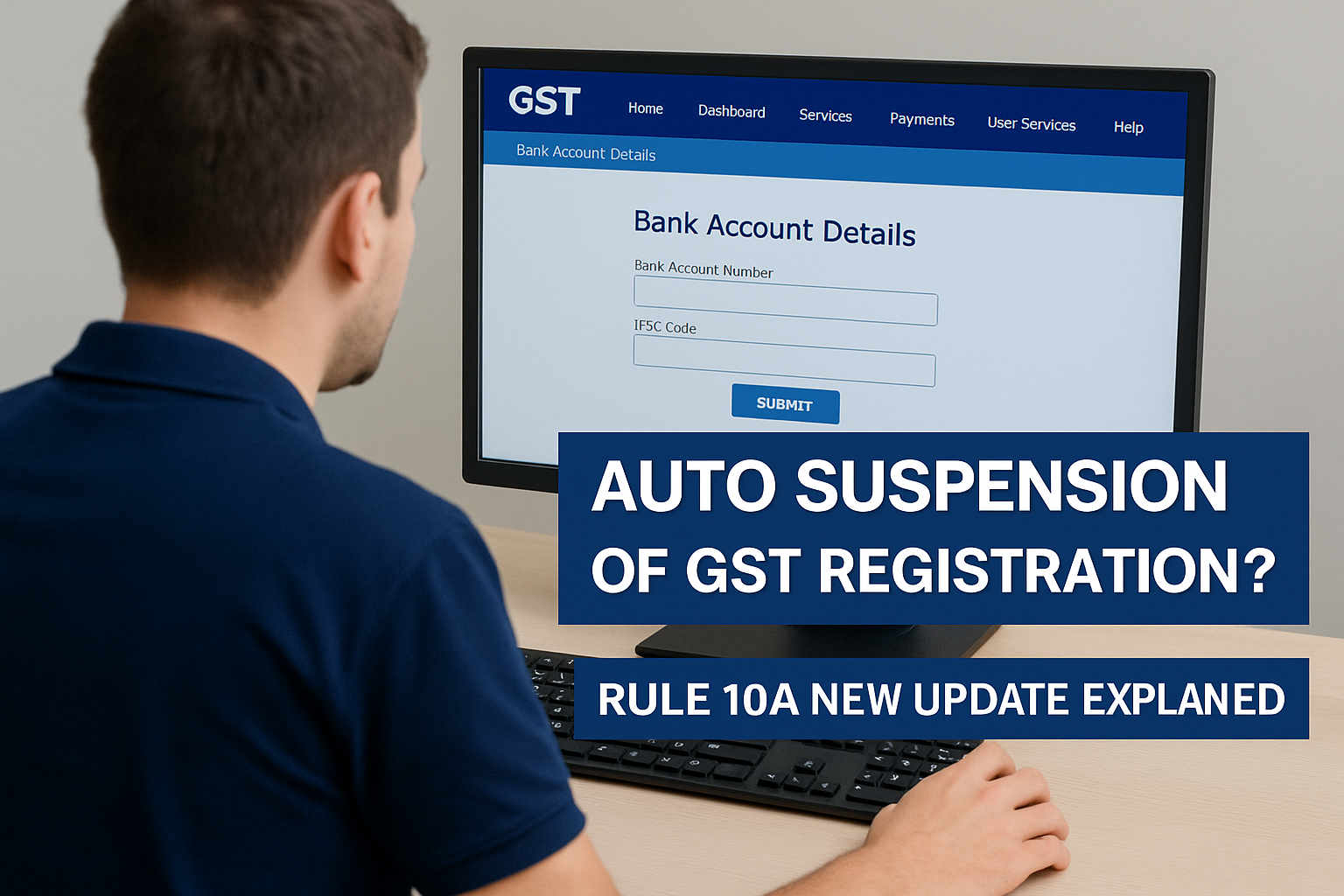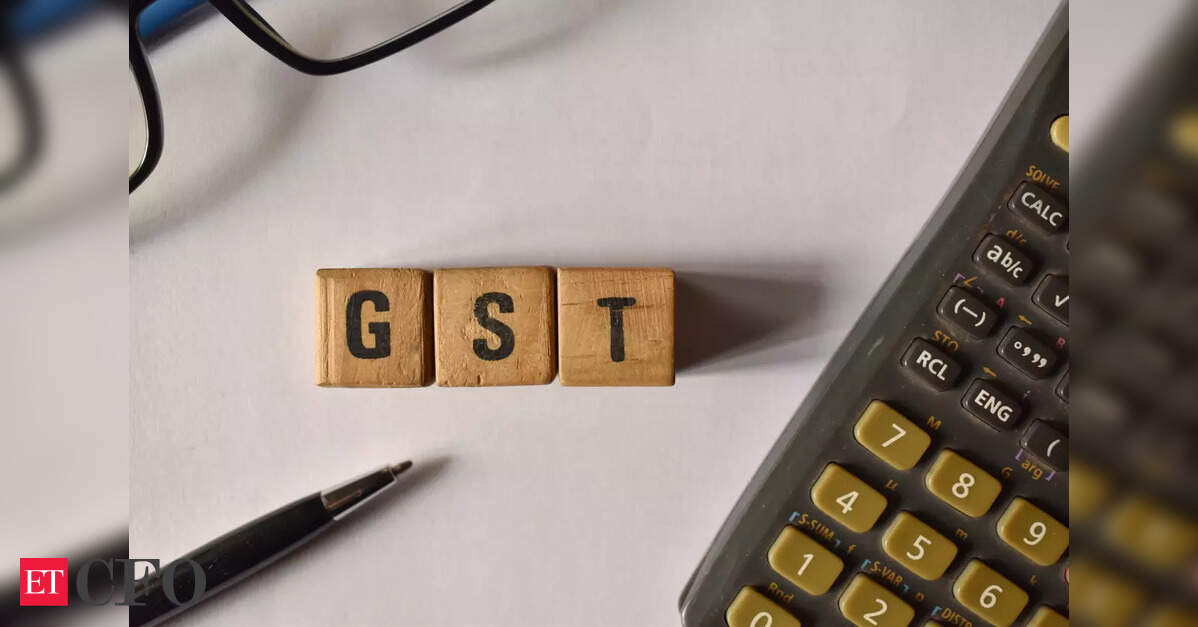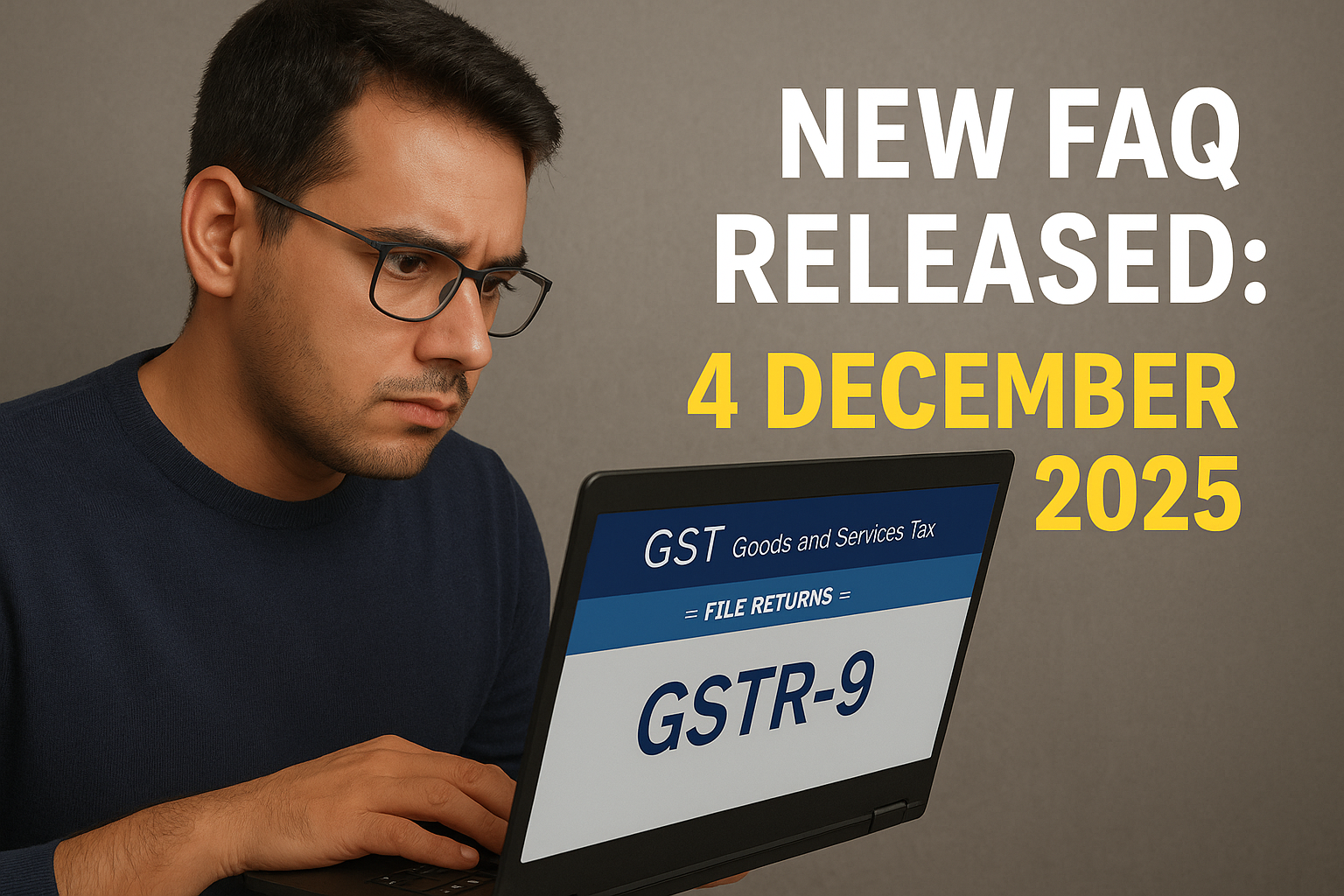GSTR-9 is the most important annual compliance under the Goods and Services Tax (GST) law. It provides a complete summary of outward supplies, inward supplies, input tax credit (ITC), tax payments, and reconciliations made during the financial year. For FY 2024-25, several important updates, validations, and reporting changes have been introduced on the GST portal, making accurate filing even more critical for taxpayers and practitioners.
This article explains what GSTR-9 is, who should file it, due date, table-wise details, new changes for FY 2024-25, common mistakes, checklist, and expert tips to ensure error-free filing.
1. What is GSTR-9?
GSTR-9 is an annual GST return that consolidates:
- Monthly/Quarterly details filed in GSTR-1
- Tax liability and ITC details filed in GSTR-3B
- Inward supply information available in GSTR-2B
- Book of accounts data of the taxpayer
It acts as a yearly reconciliation statement and is considered a key document during departmental audits, scrutiny proceedings, and assessment cases.
2. Who Should File GSTR-9?
The following registered persons must file GSTR-9 for FY 2024-25:
- All regular taxpayers under GST
- SEZ units and SEZ developers
- Taxpayers whose aggregate turnover exceeds 2 Crore.
Not required to file GSTR-9:
- Composition taxpayers (GSTR-4 is relevant for composite taxpayers)
- Input Service Distributors (ISD)
- Non-resident taxable persons
- Casual taxable persons
3. Due Date for Filing GSTR-9 (FY 2024-25)
The statutory due date for filing GSTR-9 for FY 2024-25 is 31st December 2025, unless extended by the government.
Late filing attracts late fees under Section 47 of the CGST Act, which can be significant for high-turnover businesses. Hence, early reconciliation is strongly advised.
4. Key Changes in GSTR-9 for FY 2024-25
For FY 2024-25, the Government has introduced several new tables and refined existing disclosures in GSTR-9 to ensure better reconciliation between books, GSTR-1, GSTR-3B, and GSTR-2B. These changes are aimed at capturing cross-year ITC movement more accurately, improving invoice-level matching, and reducing the possibility of mismatch notices.
1. Introduction of Table 6A1 – Prior Year ITC Claimed in Current FY
Earlier, all ITC availed during the financial year was consolidated in Table 6A.
From FY 2024-25, GSTR-9 now contains a new Table 6A1 for reporting:
- ITC pertaining to FY 2023-24
- Claimed in FY 2024-25
- Excluding ITC reclaimed under Rule 37 or Rule 37A
This helps the department differentiate between current-year ITC vs. previous-year ITC, especially where suppliers upload invoices belatedly or taxpayers avail ITC late.
2. Modified Structure of Table 6A (Now Split into 6A1 & 6A2)
To support clearer classification, the earlier Table 6A is now effectively split as:
- Table 6A1: Prior year ITC taken in current year
- Table 6A2: ITC actually pertaining to FY 2024-25
This bifurcation reduces confusion during audit and makes cross-year tracking of ITC transparent.
3. Revision of Table 8A – Exclusive FY Data Inclusion
Table 8A is now refined to show only those inward supply invoices which pertain to FY 2024-25, even if the supplier reports the invoice later (in GSTR-1 filed between April to October 2025).
Previously, late-reported invoices appearing in GSTR-2A/2B often caused mismatches.
The new rule ensures:
- Cleaner ITC comparison
- Reduced Table 8 mismatch
- Better clarity on ITC eligible vs. ineligible
4. Introduction of Table 8H1 – Imports ITC Claimed in Next FY
A new table — Table 8H1 — has been added to separately disclose:
- ITC on imports pertaining to FY 2024-25,
- But claimed in FY 2025-26
This table is extremely important for businesses where import invoices arrive late or BOE (Bill of Entry) filing happens after the financial year.
It helps the GST system validate import ITC against ICEGATE data and prevents inflated ITC claims.
5. Enhanced Structure in Table 9 – Tax Paid vs. Tax Payable
Table 9 has been redesigned with:
- A new field for Total Tax Paid (cash + ITC)
- A new field showing difference between liability and tax paid
Any shortfall automatically reflects as “pending liability”, inviting rectification through DRC-03 or assessment notices.
6. New Bifurcations Added in Table 7 – FY 2024-25
Separate fields for:
- Reversals under Rule 37 (Payment not made to supplier within 180 days)
- Reversals under Rule 37A (Reclaim of ITC mismatches based on supplier non-filing)
- Reversals under Rule 42 (Proportionate reversal for exempt + taxable supplies)
- Reversals under Rule 43 (Capital goods based reversal)
- Blocked ITC under Section 17(5)
These fields were earlier clubbed together, making it difficult for taxpayers to report correctly, now they are independent and clearly defined.
7. Clarifications in Tables 10 & 11 – Amendments Reporting
Tables 10 and 11 continue to capture amendments related to FY 2024-25 but reported in FY 2025-26.
With newer validations:
- Only correct-year amendments will be accepted
- Wrong-year amendments will trigger error messages or audit queries
8. Table 12 & 13 – Cross-Year ITC Movement
These two tables are now more tightly aligned:
- Table 12 → ITC of FY 2024-25 reversed in FY 2025-26
- Table 13 → ITC of FY 2024-25 availed in FY 2025-26
These help ensure that ITC movement across years is fully traceable.
9. New Download Excel File for HSN wise Details of Outward Supplies is available
5. Table-wise Breakdown of GSTR-9
Below is a clear breakdown of each important table and how to fill it correctly.
Table 1–3: Basic Details
Contains auto-filled information such as:
- Financial year
- GSTIN
- Legal and trade name
Ensure correctness, especially if there were amendments to legal name during the year.
Table 4: Outward Supplies (Taxable)
Report the following:
- Taxable outward supplies
- Zero-rated supplies (with payment of Tax)
- Deemed supplies
- RCM-based inward supplies
- Inward Supplies liable to reverse charge
Key Tip:
Reconcile GSTR-1 vs Books vs GSTR-3B before filling this table.
Table 5: Non-Taxable Outward Supplies
Report:
- Exempt supplies
- Zero-rated supplies (without payment of Tax)
- Nil-rated supplies
- Non-GST supplies
Correct classification is important because errors here distort turnover and tax ratios.
Table 6: ITC Availed During the Year
Includes:
- ITC availed through GSTR-3B
- ITC on import of goods
- ITC on reverse charge
- ITC on input, input services, and capital goods
- ITC of previous year claimed in this FY
Maintain a detailed ledger of ITC components to avoid mismatches.
Table 7: ITC Reversed and Ineligible ITC
Report reversals under:
- Rule 37 (non-payment to vendor)
- Rule 42 & 43 (mixed use & capital goods)
- Blocked ITC under Section 17(5)
- ITC reversed for exempt supplies
Ensure reconciliation between books and 3B figures.
Table 8: ITC Reconciliation with GSTR-2B
This is one of the most sensitive tables.
Report:
- ITC as per GSTR-2B (Table 8A)
- ITC as per GSTR-3B
- Ineligible ITC
- ITC reversed or lapsed
Any mismatch here often results in scrutiny or notices.
Table 9: Tax Paid Summary
Report:
- Tax paid as per GSTR-3B
- Cash & credit ledger usage
- Interest, penalty, and late fee paid
This table must perfectly match monthly returns.
Table 10,11 & 14: Amendments for Prior Period
Report amendments affecting FY 2024-25 but filed in next FY.
Avoid including amendments related to earlier years.
Table 12 & 13: ITC of Previous Year Availed in Current Year
Report ITC:
- Availed in the FY 2025-26 but belongs to FY 2024-25
- Reversed earlier but reclaimed later till 30th November 2025
This helps the department track cross-year ITC movement.
Table 17 : HSN-wise Summary
For taxpayers above the specified turnover, include HSN-wise reporting for outward and inward supplies.
Ensure book-wise HSN summary is prepared beforehand.
Checklist Before Filing GSTR-9
Use this checklist for error-free filing:
- All GSTR-1 returns filed
- All GSTR-3B returns filed
- Books reconciled with GSTR-1 for sales
- ITC reconciled with GSTR-2B
- RCM liabilities correctly paid
- ITC reversals updated
- All debit and credit notes recorded correctly
- Imports and SEZ supplies reconciled
- HSN summary prepared
- DRC-03 payment (if required) completed
- Final review done with books of accounts
How to file GSTR-9
Watch below video
Practical course on GSTR-9 filing
Enroll in our Advance and Practical course on GSTR-9 filing FY 2024-25
Visit www.cagurujiclasses.com for practical courses











